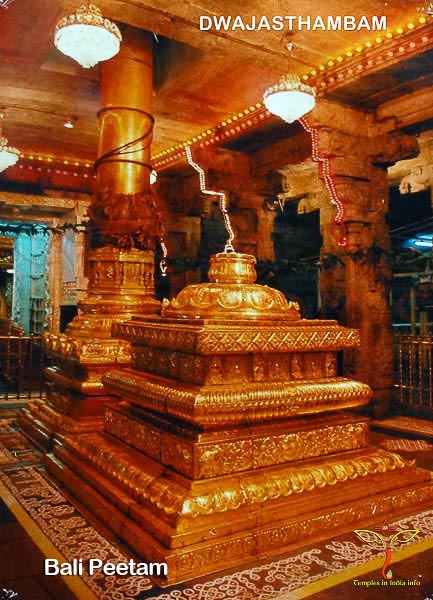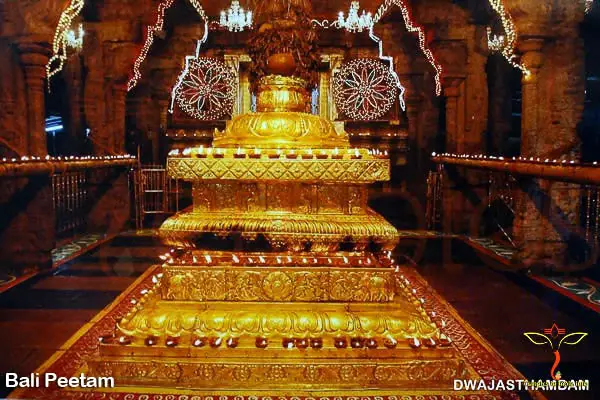Bali Peetam is inside Shri Venkateswara Swamy temple Which is covered with a gold plate and maintained by Tirumala Tirupati Devasthanams.
Abutting the flagstaff is the Bali Peetam or altar. After offering food (Prasadam) to the Lord and other deities and after exiting through the silver gate, the Prasadam is kept on this altar.
It is believed that this food offering is accepted by deities, the angles and the elemental forces. After saluting the Dwajasthamba and Balipeetam let us move to ‘Kshetrapalaka’ sila by chanting Govinda… Govinda…, the name of the Lord who is the repository of Dharm.



What is Bali Peetam:
In Hindu temples throughout India, whether dedicated to Shiva, Vishnu, or Goddess Shakti, there is a significant architectural element known as the Bali Peetam. Typically located near the temple flag pole or Dwajasthambam, the entrance point facing the main shrine, the BaliPeetam is a vital feature. The Dwajasthambam, often called “kodimaram” in Tamil, is an essential part of this arrangement. Traditionally, departing devotees would bow down on the right side of the flagpole and BaliPeetam after their prayers at the temple.
The Bali Peetam is a dome-like structure typically made from solid granite, positioned between the flagpole and the temple’s Dwajasthambam. It’s uncommon to see the flagpole outside of the temple grounds. According to the Shilpa Shastra, the Bali Peetam can be crafted from wood or standard construction materials. Its presence is more prominent in South Indian temples than in the North. The term “Bali Peetam” has Sanskrit roots, meaning a sacrificial platform or pedestal often adorned with a lotus flower image surrounded by carved petals.
Most Hindu temples have a single Bali Peetam, although a few might have one or more, with the eastern-facing one being the central focus of worship and reverence.
As part of the daily morning puja rituals, priests offer prasadam (Naivedyam) prepared in the temple kitchen (Madappalli) to the main deities, celestial beings, kshetrapala (guardian deities), and others, both within the inner sanctum and at the Bali Peetam. Devotees eventually receive the sanctified food offering. The primary purpose of the BaliPeetam is to present the Naivedyam offerings to all the Avarana devatas of the temple to appease them.
Unfortunately, there’s a misconception that the Bali Peetam at places of worship is where animal sacrifices took place in the past. This is entirely untrue, as the concept of Bali is misunderstood. The Bali Peetam was never utilized for animal sacrifices, nor did it involve spilling blood on the peetam. Animal sacrifice has always been prohibited on temple premises. The BaliPeetam is used exclusively to offer Naivedyam (Bali) to the Avarana devatas of the temple and nothing else. These Avarana devatas are the deities surrounding the main deity. The Garbhagriha (sanctum) is typically surrounded by āvaraṇas or enclosures.
The primary intention behind placing a BaliPeetam in temples is to symbolically surrender one’s negative thoughts (Arishadvargas) and enter the temple with a pure mind, focused on the presiding deity within the inner sanctum. These Arishadvargas are the six impediments to enlightenment and liberation: Lust (Kama), Anger (Krodha), Greed (Lobha), Attachment (Moha), Pride (Mada), and Envy (Matsarya). The Bali Peetam serves as the altar where these negative influences are relinquished, enabling spiritual progress. Once conquered, a devotee is blessed with a contented life.
Spiritually and philosophically, according to Agama Sastras, before entering a place of divinity and sanctity, it’s essential to shed ego, arrogance, and other negative traits. The mind must be pure and devoid of all negativity. This is why devotees prostrate themselves in front of the Bali Peetam and flagpole – an act of humility and submission to the divine will.
When leaving the shrine after prayer, it’s customary for devotees to pray in front of the Dwajasthambam and Bali Peetam, symbolizing complete surrender and unwavering trust in the divine. Those who perform Pradakshina (circumambulation) around the temple will encounter the Bali Peetam, Dwajasthambam, and the Vahana mandapam if they are present within the temple.
Moreover, it’s essential to understand that before God, everyone is equal. Regardless of one’s opulence, status, or power, all devotees are on equal footing within the abode of God.
The food placed on the sacrificial altar (Bali Peetam) is intended for the Avarana devatas and must not be tasted by devotees. Furthermore, no one should sit or stand on the Peetam while offering prayers. In wealthier temples, the Bali Peetam may be gold-plated, as seen in the Tirupati Balaji temple, where Prasadam is placed on the altar after being offered to the deities.
Shaiva Agamas mention seven kinds of Lingas within the temple, including Shikharam, Gopuram, Dwaram, Moola lingam, Archaka lingam, Prakaram, and the Bali Peetam, the latter being referred to as Bhadra Lingam.
